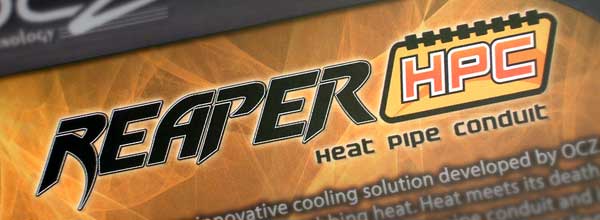OCZ Reaper Heat Pipe Conduit DDR2
Introduction
For the last several months, DDR2 memory development has been largly stagnent.
The fastest DDR2 memory kits from last summer were, for the most part, still the fastest DDR2 memory kits this spring. We haven't seen any truly significant developments in DDR2 since Micron stepped up to the plate with their D9 chips. Although manufacturers continue to release new DDR2 memory, speed increases are fewer and harder to come by.
It seems that even the mighty D9 has run out of headroom and it's becoming very difficult to produce faster DDR2 memory while still maintaining acceptible production yields.
With the relative standstill in DDR2 development, manufacturers determined to keep pushing DDR2 speed boundries have resorted to increasing voltage and improving cooling. Voltages on performance DDR2 modules now far exceed JEDEC's specification of 1.8v and values of 2.2v and higher aren't uncommon. As a result, these modules need better cooling and the standard heatspreaders that we've seen on performance RAM since the hayday of DDR are being replaced with more effective cooling methods.
We looked at the current DDR2 speed leaders back in March; Corsair's Dominator series and OCZ's Flex XLC series. Both of these product lines are good examples of recent attempts at pushing DDR2 speed boundries and they both utilize high voltages and relatively drastic cooling techniques. While Corsair went with the traditional big heatsink + fan method with their Dominator series, OCZ decided to go the water cooling route with their Flex XLC line. In recent years, heatpipe cooling has gained immense popularity in PC cooling and it was only a matter of time before they would also be applied to our memory. The wait seems to be over because the distinguishing feature of OCZ's latest line of DDR2 memory is the use of a large heatpipe assembly.
With the relative standstill in DDR2 development, manufacturers determined to keep pushing DDR2 speed boundries have resorted to increasing voltage and improving cooling. Voltages on performance DDR2 modules now far exceed JEDEC's specification of 1.8v and values of 2.2v and higher aren't uncommon. As a result, these modules need better cooling and the standard heatspreaders that we've seen on performance RAM since the hayday of DDR are being replaced with more effective cooling methods.
We looked at the current DDR2 speed leaders back in March; Corsair's Dominator series and OCZ's Flex XLC series. Both of these product lines are good examples of recent attempts at pushing DDR2 speed boundries and they both utilize high voltages and relatively drastic cooling techniques. While Corsair went with the traditional big heatsink + fan method with their Dominator series, OCZ decided to go the water cooling route with their Flex XLC line. In recent years, heatpipe cooling has gained immense popularity in PC cooling and it was only a matter of time before they would also be applied to our memory. The wait seems to be over because the distinguishing feature of OCZ's latest line of DDR2 memory is the use of a large heatpipe assembly.
|
|
|

OCZ's latest solution for cooling their high performance memory modules is the Reaper Heat Pipe Conduit (HPC) system. The Reaper HPC memory uses a combination of an aluminum heatspreader, copper heatpipe, and aluminum fin array to quickly dissipate heat. Heat generated by the memory is absorbed by the heatspreader, where it is then transported to an aluminum fin array which then dissipates the heat into the surrounding air. In theory this method should cool the memory modules much more efficiently than the flat heatspreaders most other memory modules sport. The Reaper HPC currently comes in four flavors and we've summerized the juicy details in a table for your convenience.
OCZ Reaper HPC Edition DDR2 Memory

While not as well specified as OCZ's Flex XLC series, the Reaper HPC series of memory modules certainly won't be mistaken for generic value RAM and they occupy the next highest spot on OCZ's product line. Like the Flex XLCs, all Reaper HPC memory modules get the benefit of an EPP (Enhanced Performance Profiles) programmed SPD which allows them to automatically boot at the rated specs when used on NVIDIA SLI chipsets. All Reaper HPC units are also covered by OCZ's lifetime warranty.
OCZ's Reaper HPC series originally consisted of two high performance memory kits rated at PC2-9200 and PC2-8500 speeds. Two new kits were recently added to the Reaper HPC line-up, an affordable PC2-6400 kit and a low-latency Enhanced Bandwidth Edition PC2-6400 kit. For the purposes of this article, we have obtained the original PC2-8500 Reaper HPC kit and the new Enhanced Bandwidth Edition PC2-6400.
OCZ's Reaper HPC series originally consisted of two high performance memory kits rated at PC2-9200 and PC2-8500 speeds. Two new kits were recently added to the Reaper HPC line-up, an affordable PC2-6400 kit and a low-latency Enhanced Bandwidth Edition PC2-6400 kit. For the purposes of this article, we have obtained the original PC2-8500 Reaper HPC kit and the new Enhanced Bandwidth Edition PC2-6400.








